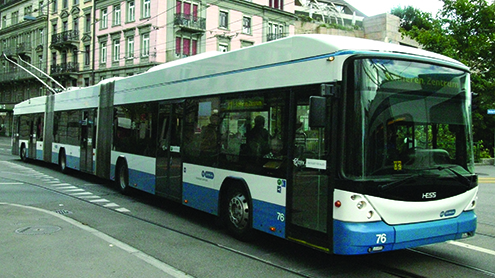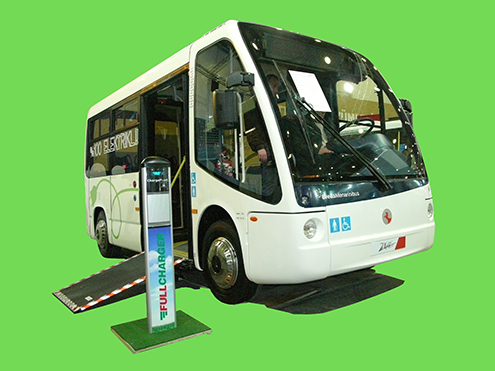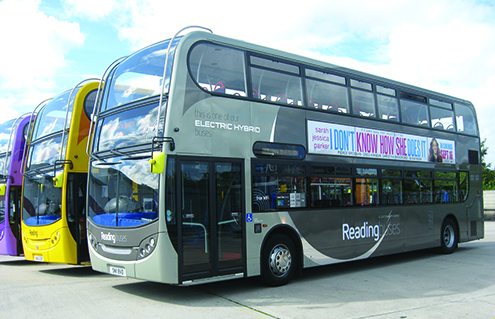
By Doug Jack
A growing view of city transport in Europe sees all-electric vehicles as the future. On a relatively small scale, a number of projects are in various stages of development with some already complete and others in the planning stage.
All-electric traction has been around for many years in the form of trolleybuses such as VBZ, Zurich, Switzerland, that draw electric current from overhead wiring, which is unsightly and expensive to maintain. However, some of the latest models can be fitted with batteries or super capacitors batteries giving them the capability to run short distances off-wire.

The electrification lobby received a major boost in March when Scania and Siemens entered into a partnership to electrify powertrains in Scania trucks and buses. Headquartered in Sweden, Scania is one of the world’s leading manufacturers of premium buses and coaches. Based in Germany, Siemens is one of the world’s most prominent and diverse producers of electric equipment, including drive motors.
The partnership makes Sweden the world’s first country with all-electric powered trucks and buses and electrified roads for commercial use. At the time of the announcement, the two companies unveiled a truck equipped with a pantograph on the roof that receives power from overhead wires.
“Full-scale electrified road sections can quickly become a reality through this partnership,” says Henrik Henriksson, Scania executive vice president, sales and marketing. “Fuel savings made possible by electrification are huge and this project is the foundation for fossil-free road transport.”
Strictly speaking, fossil-free is only true if the electricity is hydro or nuclear generated.
Scania sees the development of electric vehicles as an important part of the transition to more sustainable transport systems. Scania says an electrical transmission through a conduction line in the air or powered through the road surface can supplement a hybrid powertrain, making a vehicle completely electrically powered on electrified roads. Buses and local distribution trucks can share the same electrical circuits in urban centers.

Hybrid buses are running in most European countries, with Volvo in the leading position in terms of deliveries and orders with its ISAM parallel drive system. Alexander Dennis and BAE Systems offer a similar facility called Arrive and Go in their series hybrid system.
Volvo hybrid buses are achieving savings in fuel consumption of up to 40 percent compared with standard diesel equivalents. The company will raise that barrier in a project later this year in Gothenburg, in which buses will receive a fast boost of electricity while stopped at each end of a route. This will enable them to run longer in an all-electric mode and be programmed to run only electrically in busy central areas. Volvo is confident of achieving savings exceeding 60 percent in fuel consumption. Regular boosting of the batteries during daytime can reduce the number of batteries, saving weight and allowing more passengers onboard.
The use of inductive charging to boost battery power has been available in Europe for at least 10 years, but only a few systems have been installed. One of the first was in the Italian port city of Genoa. A metal plate was sunk into the road surface at each end of the route. When the bus parked over the plate, a contact on the underside of the vehicle connected with the plate, taking a fast boost charge. The plate is harmless to others on the road when not in use.
More recently, Bombardier, well known in Europe for trains and trams, has introduced its Primove induction charging system of wiring laid beneath the road surface at busy bus stops and at each end of the route. Vehicles can take a fast charge whenever they are stationary for a minute or more.
The Primove system can be used in any other vehicles equipped to take a fast charge. It works rather like road tolling, with users charged for the amount of energy consumed at the end of each month.
Wrightbus, the innovative bus manufacturer based in Northern Ireland, is leading a consortium that will deliver eight all-electric midibuses to Milton Keynes in England later this year. The buses will use inductive charging by Conductix-Wampfler, a U.S. company that supplies automated guidance systems for vehicles in factories.
William Wright, still leading the company’s projects on alternative fuels at the age of 85, has some very interesting views on batteries. His company is currently using lithium-ion, which is in short supply. As demand increases and prices rise, he believes the solution may well be sodium-ion. Sodium-ion is readily available and works better at lower temperatures.
At $300,000, the all-electric midibus is nearly twice the price of its diesel equivalent. However, electricity is much less expensive than the European price of diesel. Wright predicts net fuel cost savings of up to $18,000 per year.
Buses operating solely on batteries have been running in Europe for several years, recharging only at a depot at the end of the day. They tend to be small vehicles used on precinct work in historic town centers with narrow streets. Their problem has always been limited range, especially if the batteries also have to power the HVAC.

With that said, battery technology is improving and we are starting to see larger vehicles with greater range capabilities. Greater range requires a greater number of batteries, however, which can restrict the number of passengers so as not to exceed maximum legal axle weight limits.
A small number of trial contracts have been signed for full-size transit buses, principally with Chinese manufacturers like BYD, and with Foton which has an assembly plant in Spain.
The British bus builder Optare has been offering all-electric versions of its Solo and Versa midibuses for four or five years. Deputy CEO Glenn Saint has been closely involved in the development. He believes that plug-in recharging is much less expensive and easier to install than either conductive or inductive systems. Saint is not an advocate of compressed natural gas as a fuel for buses. He believes it is much more efficient to convert gas to electricity.
EMT, the principal operator in Madrid, Spain, has a number of hybrid buses which use a CNG-fueled thermal engine. These give very clean emissions but are quite complicated, with all the hybrid equipment plus gas storage tanks.
In the medium to longer term, electricity may well be the answer. Further developments are inevitable, and it will take time to refine systems so that they become thoroughly reliable and achieve the required operating range. BR
Doug Jack is with Transport Resources in the United Kingdom.
